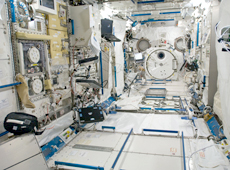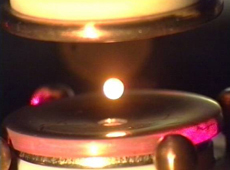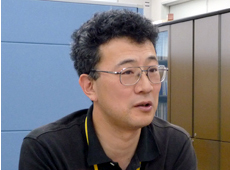Q. What kind of materials science experiments are scheduled now?

Inside Kibo’s Pressurized Module (courtesy: NASA)
With regards to Marangoni convection, we would like to continue to collect data, so the experiment is scheduled to run for another five years or so. As for the ice crystal experiment, there is a project to form a crystal using not pure water this time but water with protein added. The blood of deep-sea fish does not solidify despite the fact that the fish live in an environment of -40°C, which is much lower than the usual freezing point of blood. So, by mixing fish protein with water to make it harder to solidify, we will study how crystallization takes place under such conditions.
Furthermore, a new experiment rack, which we’re calling Kobairo, will be delivered to Kibo on the H-II Transfer Vehicle 2, which is scheduled for launch in 2010. An experimental facility called the Gradient Heating Furnace will be installed in the Kobairo rack to conduct experiments on crystal growth of semiconductors in space. We hope to understand the crystal growth process of semiconductors, in order to produce better-quality crystals and establish a new manufacturing method.
Experiments with the Gradient Heating Furnace will start in 2011. In addition, two or three years from now, the Multi Purpose Small payload Rack (MPSR) will be developed and delivered to the ISS. An incert for combustion experiments now in development will be installed in the MPSR rack, and a series of combustion experiments will start.
Q. What experiments are you particularly interested in?

Hot sample being levitated in the Electrostatics Levitation Furnace
My own research focuses on melting and solidifying materials in containerless condition. There are many benefits to doing containerless processing experiments in space as well as on Earth. On the ground, acoustic pressure, electro-magnetic force or Coulomb force is used to levitate materials against gravitational forces, but in space this force can be minimized. On Earth, you need a container, such as a glass, to hold water; in space water gathers in a sphere and floats by itself. This is a great advantage because you can heat or cool material directly, without worrying about the container. For example, if you heat material in a glass container at 3000°C, you will also melt the container. Without a container, it is possible to melt materials in higher temperature than we can on Earth. Eliminating the need for a container also prevents interaction between molten samples and containers.
Another advantage of containerless processing experiments is that you can easily keep the molten samples under their melting points (this is known as a supercooling state), which could allow us to develop a new way of solidification. Research on using levitation to develop new materials can help produce better dielectric materials and optical glass. So we are now developing an experimental facility for Kibo called the Electrostatics Levitation Furnace (ELF). ELF will allow us to use the microgravity environment to melt and solidify materials such as glass in containerless condition. Concretely speaking, we float a sample using electrostatic force, and use high power laser beams to heat it to more than 2000°C. The processes of the melting and solidification of the materials will be monitored with radiation thermometers and cameras.
We will also measure thermophysical properties of molten materials at high temperature, including their density and viscosity. The ELF is already in practical use on the ground. We are planning to launch it after making it compact and improving its safety.
I have been supporting such experiments as Marangoni and ice crystal as a engineering staff, but with this ELF, I’d love to conduct space-based experiments for my own research.
Q. What is the next objective of materials science experiments on Kibo?

I think the next objective is to make significant achievements. To do so, rather than doing a wide range of experiments to please everyone, I think it is very important to choose specific areas to focus on, and to stick to experiments in those areas. I would like to make full use of the experiment facilities on Kibo to collect as much data as possible, by varying experimental parameters, for example, and focusing on making sure all our results are reproducible and reliable. With these reliable data, I am hoping that Japan will establish a leading position in research on crystal growth and fluid mechanics. I believe that this work will contribute to the development of new materials, which will eventually enrich our life on Earth.


